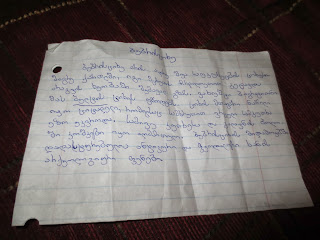Hello! If you’ve
found yourself here, I would like to take this opportunity to thank you for
visiting this blog. Please take a moment
to read through what is written here, if you’ve got any comments please add
them.
This is a blog about an old fortress in the city of
Mtskheta, Georgia. The fortress is
called Bebris Tsikhe, and it sits on a hilltop in the northern part of
city.
The fortress, which is just a couple of kilometers from
Mtskheta’s Old Town area, provides a very scenic view of the surrounding
area. If you’re a photographer visiting
Georgia, I highly recommend making the short visit to this fortress. You can travel on foot from Old Town Mtskheta
to this structure safely.
Let me provide some background about why I am writing this
blog. I am an American living in the
country of Georgia. I was recently
tasked with coming up with some sort of project about the history of the area
where I work. I wasn’t sure what I
should write about. I take a marshutka
from Didube to Mtskheta every morning. Every
morning my marshutka ride takes me past Bebris Tsikhe and every morning I stare
up at it.
I became very curious about Bebris Tsikhe. I decided to do some searching on the
internet to see if I could find any English language information about this old
fortress.
Internet searches provided very little English language
information about this structure. Google searches for Bebris Tsikhe brought back mostly photographs as results. Bing search results were also very
similar. Bebris Tsikhe doesn’t have an
English language Wikipedia page (it does have a Georgian language page). I have an English language travel book about
Georgia – this book mentions Bebris Tsikhe briefly, but has very little information about it.
Philosophically, I am very interested in data on the
internet. I am also interested in the
intersection of location and information.
I believe that a very inexpensive way to improve the economy of Georgia
would be a program to expand information about Georgia on the internet. Here’s an example, the restaurant review
website Yelp just expanded into Poland –
this is the kind of service that Georgia needs.
I hope that by doing this blog it will in some small way contribute to the amount of information that is on the
internet about Georgia Plus, I love
sharing photographs that I take here in Georgia!
…
I decided to ask some people in Mtskheta about Bebris Tskihe. Many people in Mtskheta indicated to me that
the history behind the structure isn’t taught.
They told me that there’s basically just legends about the castle that
everyone passes down.
I asked some of my Georgian friends if Bebris Tsikhe appears
in any Georgian language history texts.
I was told that no one could recall ever studying about Bebris Tsikhe in
a Georgian language history book. If
you’re interested, you can do a search on google.ge for Bebris Tsikhe.
Unfortunately, all of the returned results are in the Georgian language.
I asked a Georgian history teacher to write down some
information about Bebris Tsikhe. This is
what she wrote:
“Bebris Tsikhe is an early to mid centuries castle in
Kartli. It used to block the north side
road of Aragvi ravine, this road went to Mtskheta. Vakhushti Bagrationi called it 'Belta
Fortress.' The main part of the fortress
was a citadel, which was surrounded by a triangular yard. There used to be three castles at three
angles. There is archaeological evidence
that there are antique and feudal age layers."
I also asked some of my Georgian co-teachers about the myths associated with the fortress:
According to legend, this castle once belonged to a noble
man named Simon. Simon had two
children. One of his children was the beautiful Makrine
and the other the heartless Mamuka. After the death of
Simon, Mamuka charged local peasants at a high tax rate. Makrine felt sorry for the peasants, and
asked Mamuka to lower their tax rate.
Mamuka became furious at the request and locked Makrine in the castle.
One day, while some very watery and tasteless soup was being
made for the peasants, a group of crows fell into the saucepans. Peasants poured all the soup away. Mamuka became very angry at seeing the waste
of food. Mamuka began to chase the
peasants.
Suddenly snakes came out of
the saucepans and began circling Mamuka.
Mamuka feared for his life, and called out to God: “Help me and I will
build you a church!”
Makrine witnessed this entire episode and began to
pray. God heard this prayer and Mamuka
and Makrine began living a religious life.
Makrine became a nun and Mamuka became a monk.
Makrine ended up dying at 70 years of age. On the day of her funeral, a white bearded
man visited her body, kissed her forehead, and said: “My sister, we have
fulfilled our promise!”
After saying these words, he fell down and died. This is why this fortress is called “Bebris Tsikhe,”
which means “The Elder’s Fortress.”
That's the legend of Bebris Tsikhe. If you have the chance, you should visit it!
That's the legend of Bebris Tsikhe. If you have the chance, you should visit it!


Hi,
ReplyDeleteAs I read, Bebris Tsikhe is the ruins of a 3rd-century citadel, later rebuilt in the 9th and 11th centuries.
Any information on who built this citadel? and who rebuilt in the 9th and 11th centuries?